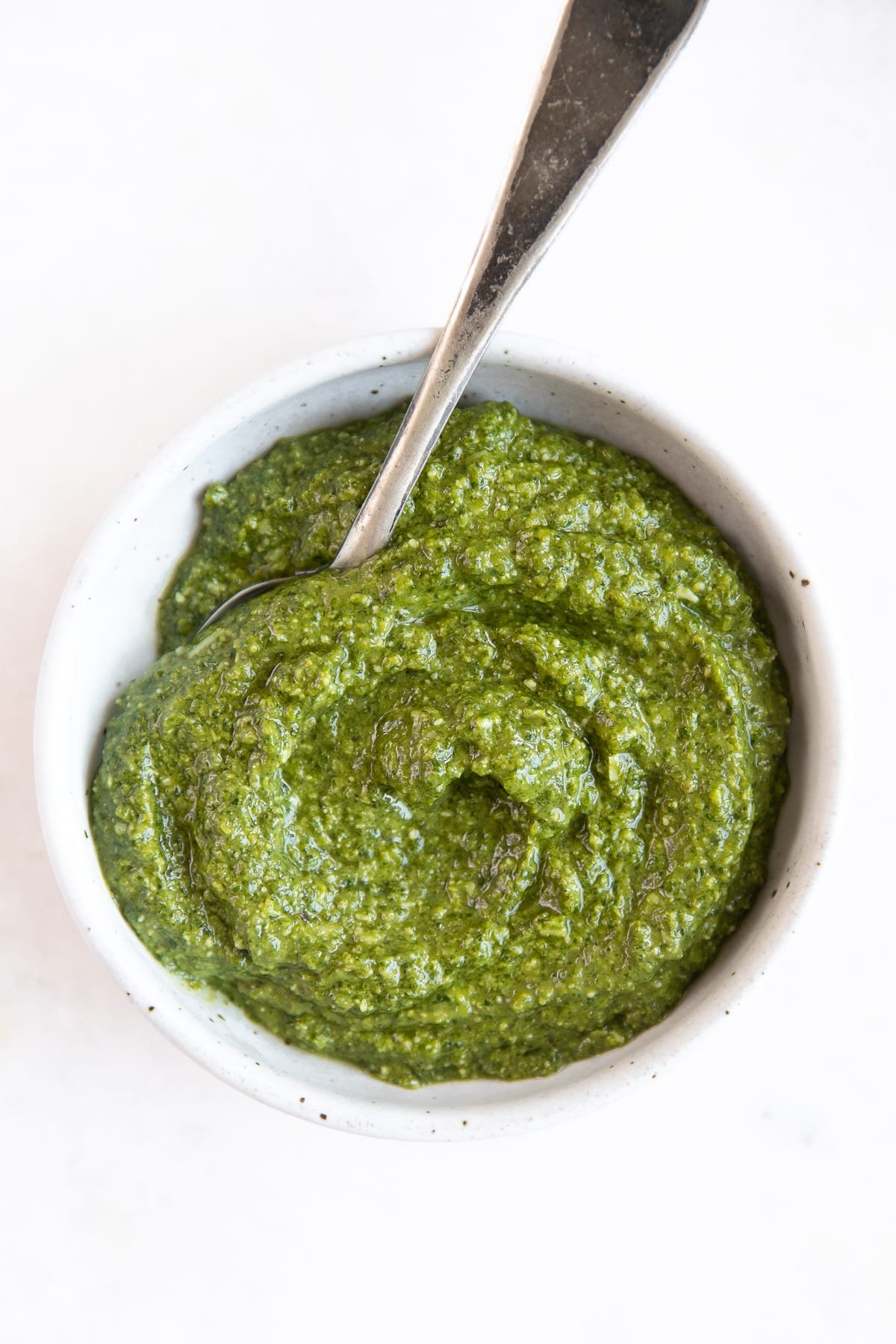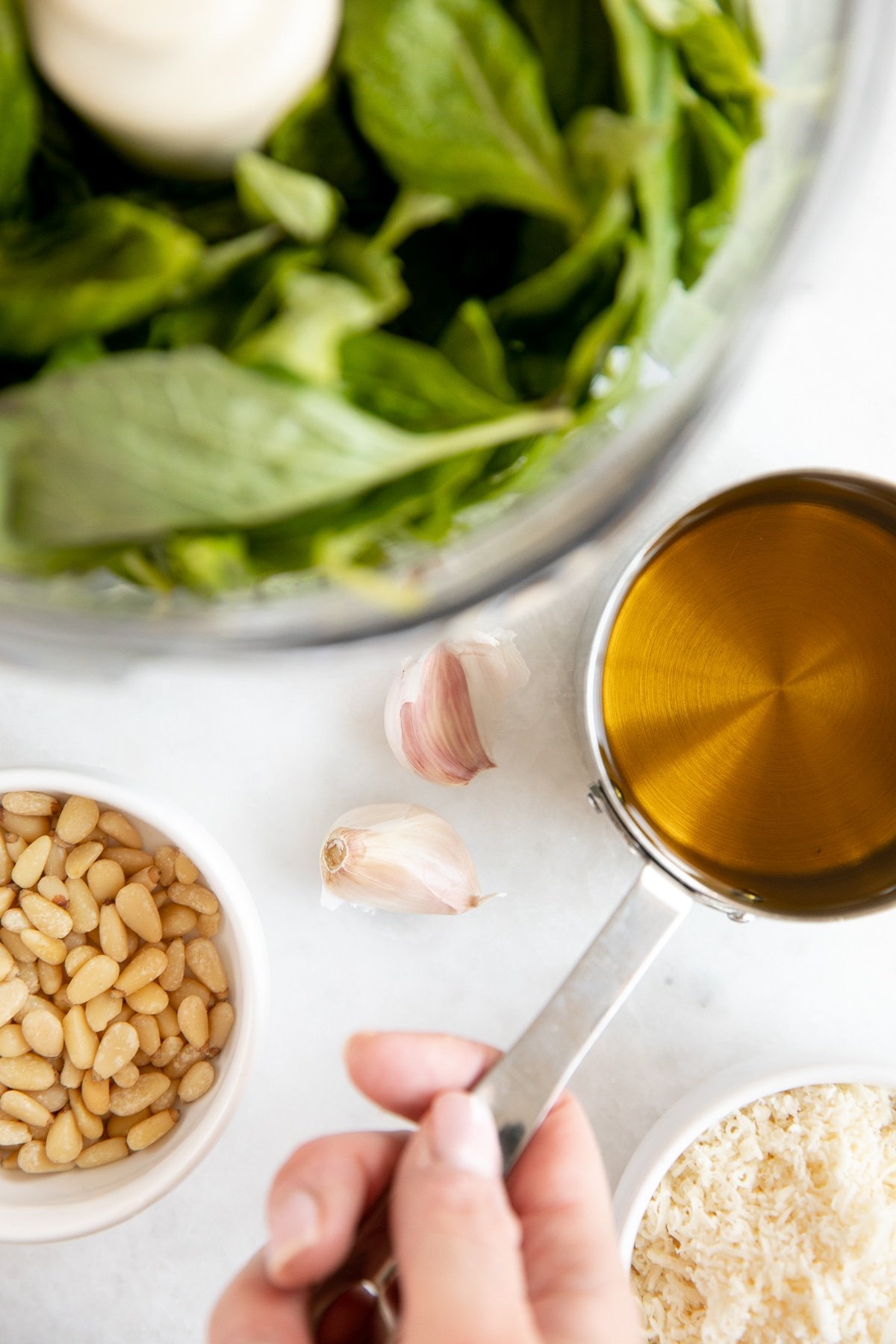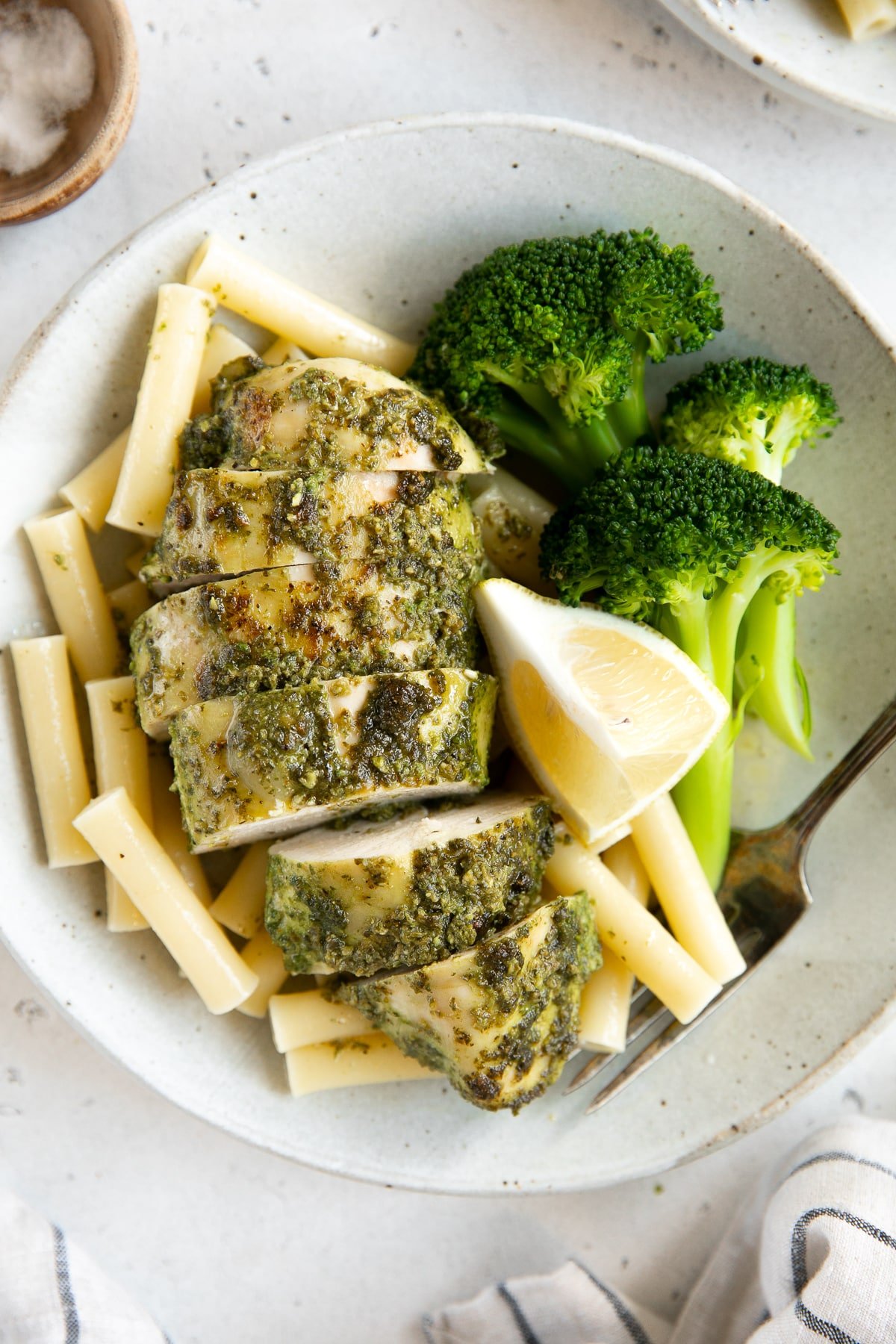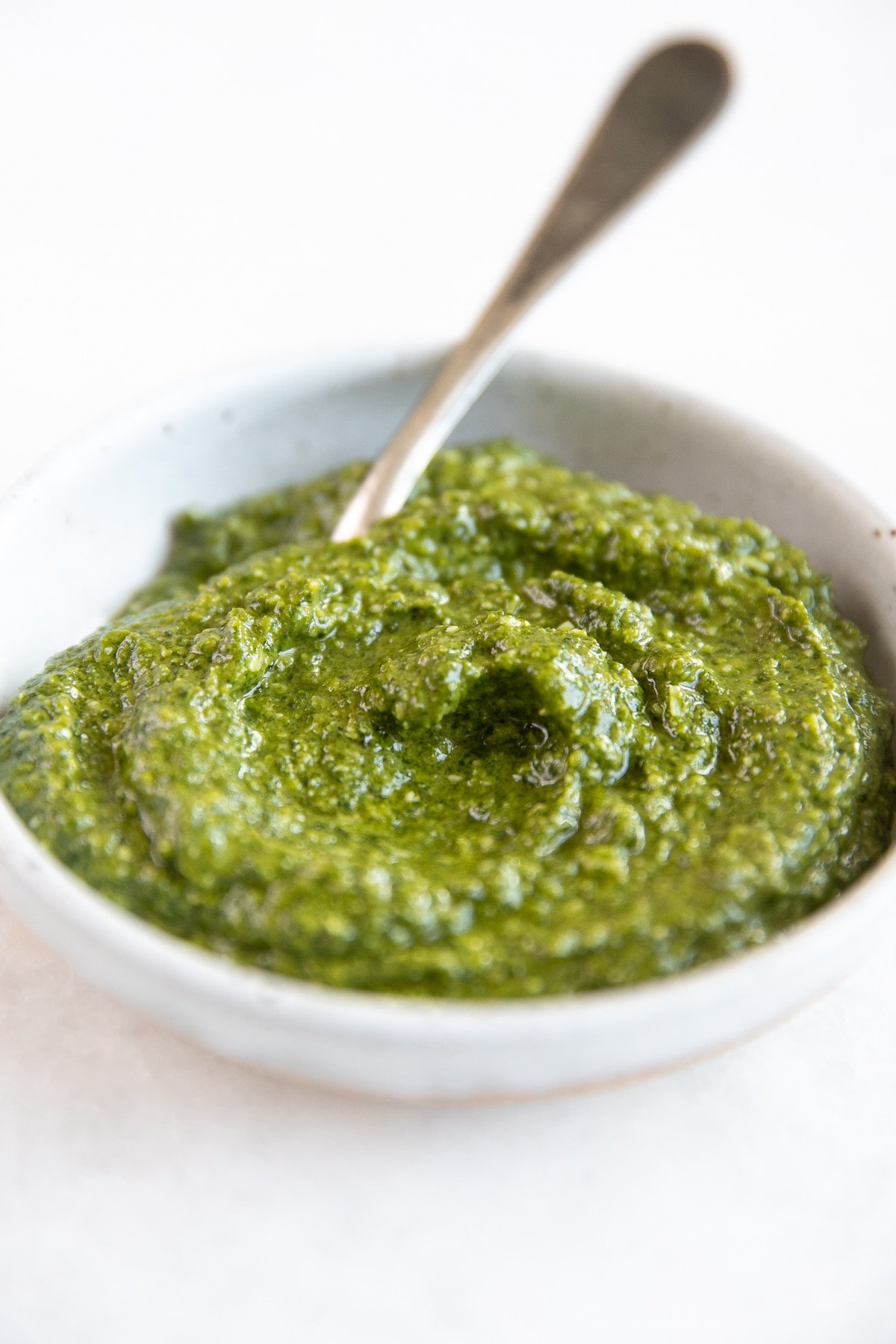This post may contain affiliate links. Please read our disclosure policy.
This Homemade Basil Pesto is fresh, flavorful, super quick to make, and one of my all-time favorite sauces. It’s made with just five simple ingredients and is incredibly delicious on pasta, pizza, sandwiches, and more! This recipe is gluten-free & Vegetarian.
Love pesto sauce? You may also like my Baked Pesto Chicken Recipe, this Creamy Pesto Gnocchi, or this summertime Pesto Pasta Salad.

About This Recipe
This is my favorite basil pesto. It uses traditional ingredients: pine nuts, fresh garlic, fresh basil, extra-virgin olive oil, freshly grated Parmesan (or Romano) cheese, and a bit of salt to taste. We’re using a food processor to blend everything together (because it’s faster and easier), but feel free to use a mortar and pestle if that’s more comfortable. Check out the ingredient section below for notes and substitutions.
- Difficulty: Ready in just a few minutes! So easy!
- Freezer-Friendly: Yes. However, it’s best to freeze before adding the cheese.
- My Top Tip: Adjust the ingredients to your taste. This includes the type of cheese used, the amount of salt added, or even the addition of lemon juice for brightness.
Table of Contents
What is Pesto?
Pesto, also known as “pesto alla Genovese,” is an uncooked sauce originating in Genoa, Italy. It is traditionally made by blending fresh basil leaves, garlic, pine nuts, Parmigiano-Reggiano (Parmesan cheese), Pecorino cheese, and extra-virgin olive oil in a mortar and pestle until it reaches a smooth yet slightly textured paste. These days, pesto is typically made with the help of a food processor or blender.
Ingredient Substitutions and Variations
Before making this recipe, remember that basil pesto should be made to taste. For example, some people may prefer a bolder, saltier pesto. In this case, Pecorino romano may be preferred over classic Parmesan. Check out my notes, substitutions, and suggested additions for this basil pesto recipe below. You will find the printable recipe with measurements in the recipe card at the bottom of this page.

Fresh basil is paramount to achieving delicious basil pesto. I recommend purchasing a little more than the recipe calls for, as some leaves may not be as fresh. Remove the stems before processing.
- Basil substitutions: Spinach (mild and sweet), arugula (peppery and bold), kale (earthy and slightly bitter), or cilantro (fresh and citrusy, perfect for Tex-Mex).
Pine nuts: Pine nuts add a creamy texture and subtle nuttiness. They are found in traditional pesto recipes but are expensive and sometimes unavailable.
- Pine nut substitutions: Almonds (sweet and crunchy), walnuts (rich and slightly bitter), pistachios (buttery and sweet), and cashews (creamy and mildly sweet). I’ve made this recipe with pistachios, and it was wonderful. Nut-free alternatives include pepitas, hemp seeds, and sunflower seeds. I have not tried making nut-free pesto, so I can’t speak personally about the taste.
Fresh Garlic: Fresh, raw garlic adds a sharp, pungent kick to pesto, which complements the fresh basil. But don’t overdo it. Too much raw garlic can overwhelm the sauce.
Hard Cheese: I added Parmigiano-Reggiano (aka Parmesan cheese) to this recipe. Delicious and available virtually everywhere, it is the most common cheese used to make pesto in the US.
- Parmesan substitutions (or additions): Pecorino romano cheese (a hard cheese made from sheep’s milk) that is saltier and sharper than Parmesan. Highly recommended for a stronger umami flavor. Nutritional yeast is a great vegan alternative for its cheesy, umami-rich flavor.
Olive oil: A high-quality extra virgin olive oil is ideal.
Optional Additions
- Lemon juice (for brightness), red pepper flakes (for a little heat), and/or honey (to balance any bitterness.

How to Make Basil Pesto
To begin, gather the ingredients and prepare the basil. Trim the stems from approximately 3-4 packed cups of fresh basil. Discard the stems, rinse the leaves in fresh, cool water, and dry them thoroughly (a salad spinner works great here).
Traditionally, a mortar and pestle is used to gently grind the ingredients until a smooth yet textured sauce forms. If you have a mortar and pestle, feel free to use it! Otherwise, using a food processor to make basil pesto is perfectly okay.
To begin, pulse the nuts and garlic in the food processor until finely chopped, scraping down the sides as needed. This ensures an even texture. Add the basil next. Pulse in short bursts to avoid overheating the basil (causing it to turn brown). Then, with the food processor running, drizzle the oil into the food processor in a slow and steady stream. Process until mostly smooth. Finally, fold in the parmesan cheese just until combined.
Season with salt and squeeze of fresh lemon juice to taste.


How to Use This Homemade Basil Pesto Recipe
The most popular use for basil pesto is pasta, but there are many more ways to use this fresh pesto sauce. Enjoy it on pizza by swapping traditional red sauce for this homemade basil pesto. Serve it with fried or scrambled eggs, omelets, or quiche. Enjoy it with your favorite proteins, like shrimp, beef, or chicken (this baked pesto mozzarella chicken is delicious). Toss with roasted potatoes and veggies or add it to salads like this Caprese and fresh tomato salad. Spread it over sandwiches and grilled cheeses, swirl it into soup, like this yummy minestrone, or mix it into this cheesy mac n cheese or creamy alfredo sauce.

Storage and Freezing Tips
Transfer leftover pesto to an airtight container and top with a thin layer of olive oil. The top layer of oil helps prevent the pesto from browning. Cover with plastic wrap, allowing the plastic wrap to touch the oil directly, and transfer to the refrigerator for up to 5 days.
For best results, freeze the pesto before adding any cheese (add it later after it has been defrosted). Fill a silicone ice cube tray with pesto or freeze in a small glass container with a tight-fitting lid. Use within 4-6 months.
Looking for more delicious sauce recipes? Try my Chimichurri Sauce Recipe (great for steak and chicken), my buttery hot homemade Buffalo Sauce, and this (best-ever) Alfredo Sauce Recipe.

Have any questions? Drop me a message in the comment section below! I’m happy to help. And, if you enjoy this recipe, please rate it with some STAR LOVIN’ so other readers know to try it too! Tag me at #theforkedspoon. I’ll be sure to share! Thank you!

Basil Pesto Recipe
Equipment
Ingredients
Instructions
- Prepare the basil. Trim the stems from approximately 3-4 packed cups of fresh basil. Discard the stems, then rinse the leaves in fresh, cool water and dry thoroughly (I like to wash and dry fresh herbs using a salad spinner).
- Finely chop the nuts and garlic. Pulse the nuts and garlic in the food processor until finely chopped, scraping down the sides as needed. This ensures an even texture.
- Add the basil. Pulse in short bursts to avoid overheating the basil (which may cause it to turn brown).
- Slowly Add the Olive Oil. With the motor running, drizzle the oil very slowly into the food processor. Process until mostly smooth. Note: You may need to remove the lid and scrape down the sides once or twice as the oil is being added.
- Fold in the cheese. Mix until just combined.
- Season to taste. Season with salt and squeeze of fresh lemon juice to taste.
Notes
- Basil substitutions: Spinach (mild and sweet), arugula (peppery and bold), kale (earthy and slightly bitter), or cilantro (fresh and citrusy, perfect for Tex-Mex).
- Pine nut substitutions: Almonds (sweet and crunchy), walnuts (rich and slightly bitter), pistachios (buttery and sweet), and cashews (creamy and mildly sweet). I’ve made this recipe with pistachios, and it was wonderful. Nut-free alternatives include pepitas, hemp seeds, and sunflower seeds. I have not tried making nut-free pesto, so I can’t speak personally about the taste.
- Parmesan substitutions (or additions): Pecorino romano cheese (a hard cheese made from sheep’s milk) that is saltier and sharper than Parmesan. Highly recommended for a stronger umami flavor. Nutritional yeast is a great vegan alternative for its cheesy, umami-rich flavor.
- Optional additions: Lemon juice (for brightness), red pepper flakes (for a little heat), and/or honey (to balance any bitterness).
- Storage: Transfer pesto to a storage container and top with a thin layer of oil to prevent browning. Cover with plastic, allowing the plastic wrap to touch the oil directly. Transfer to the refrigerator for up to 5 days.
- To freeze: For best results, freeze this pesto recipe without the cheese (you can add it later after the pesto has been defrosted). Fill a silicone ice cube tray with pesto or freeze in a small freezer-safe container with a tight-fitting lid.
Nutrition
Nutrition information is automatically calculated, so should only be used as an approximation.
















I made this using organic baby greens and walnuts. Mmmmmmmmmm!!!